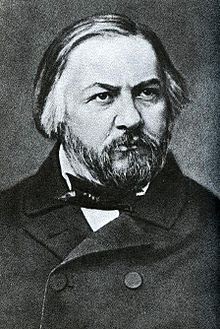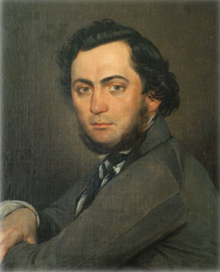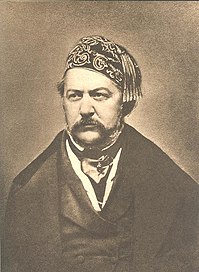| Edit | Map | Home | New Post | New Gallery |
Support
|
 | |
Mikhail Ivanovich Glinka ( May 20 [ June 1 ] , 1804 , Novospasskoye village , Smolensk province - February 3 , 1857 , Berlin ) - Russian composer . The works of Glinka influenced the largest Russian composers - A. S. Dargomyzhsky , M. P. Mussorgsky , N. A. Rimsky-Korsakov , A. P. Borodin , P. I. Tchaikovsky and others. In the words of V. V. Stasov , "both [Pushkin and Glinka] created a new Russian language - one in poetry, the other in music"[ Mikhail Glinka was born on May 20 ( June 1 ), 1804, in the village of Novospasskoye , Smolensk province , on the estate of his father, retired captain Ivan Nikolaevich Glinka (1777-1834) . His mother was his father's second cousin, Evgenia Andreevna Glinka-Zemelka (1783-1851). The composer's great-grandfather was a gentry from the Glinka family of the Trzaska coat of arms - Viktorin Vladislav Glinka ( Polish: Wiktoryn W?adys?aw Glinka ) . After the loss of Smolensk by the Commonwealthin 1654 V. V. Glinka accepted Russian citizenship and converted to Orthodoxy . The tsarist authorities retained land holdings and noble privileges for the Smolensk gentry , including the former coats of arms . Childhood and youth [ edit | edit code ]Until the age of six, Glinka was brought up by his paternal grandmother Fyokla Alexandrovna, who completely removed her mother from raising her son . He grew up as a nervous, hypochondriac and sickly child, touchy - "mimosa", according to Glinka's own characteristics. After the death of Fyokla Alexandrovna, Mikhail again passed into the full control of his mother, who made every effort to erase the traces of her previous upbringing. From the age of ten, Mikhail began to learn to play the piano and violin . Glinka's first teacher was a governess invited from St. Petersburg, Varvara Fedorovna Klammer. In 1817, his parents brought Mikhail to St. Petersburg and placed him in the Noble Boarding School at the Main Pedagogical Institute (in 1819 it was renamed the Noble Boarding School at St. Petersburg University), where his tutor was the poet, Decembrist V. K. Kyuchelbeker , whose sister Justina (1784-1871) married G. A. Glinka (1776-1818), the cousin of the composer's father. In St. Petersburg, Glinka took private lessons from prominent music teachers, including Karl Zeiner and John Field. In 1822 he successfully completed (as a second student) a course of study at the Noble Boarding School at the Imperial St. Petersburg University. At the boarding house, Glinka met A. S. Pushkin , who came there to his younger brother Leo , Mikhail's classmate. Periods of life and work 1822–1835At the end of the boarding school, Glinka worked hard: he studied Western European musical classics, participated in home music making in noble salons, and sometimes led his uncle's orchestra. At the same time, Glinka tried himself as a composer, composing variations for harp or piano on a theme from the Austrian composer Josef Weigl 's opera The Swiss Family. From that moment on, Glinka paid more and more attention to composition and soon composed a lot, trying his hand at various genres. During this period, he wrote well-known romances and songs today: “Do not tempt me without need” to the words of E. A. Baratynsky , “Do not sing, beauty, with me” to the words of A. S. Pushkin, “Autumn night, night dear" to the words of A. Ya. Rimsky-Korsakovand others. However, he remains dissatisfied with his work for a long time. Glinka is persistently looking for ways to go beyond the forms and genres of everyday music. In 1823 he works on a string ensemble, an adagio and a rondo for orchestra, and two orchestral overtures . In the same years, Glinka's circle of acquaintances expanded. He met V. A. Zhukovsky , A. S. Griboedov , Adam Mitskevich , A. A. Delvig , V. F. Odoevsky , who later became his friend. 
In the summer of 1823, together with his cousin's husband, Colonel A. I. Kipriyanov , Glinka traveled to the Caucasus, visited Pyatigorsk and Kislovodsk . Acquaintance with the music of the peoples of the Caucasus left a significant mark on the composer's creative mind and was reflected in his later works on oriental themes. So, on the basis of the Adyghe dance melodies, the composer created the "Persian choir" for his opera " Ruslan and Lyudmila " . Also, in the “Notes” of the composer, which he led for many years, Ivan Aivazovsky speaks of the direct contribution to the enrichment of the musical material of “Ruslan and Lyudmila”. In particular, the great Feodosian marine painter told Glinka three Tatar melodies, playing them on the violin (the artist owned the instrument and often played at the composer's creative evenings). Glinka himself writes about it this way: "Aivazovsky told me three Tatar melodies, subsequently I used two of them for the Lezginka, and the third for the Ratmir's Andante stage in the 3rd act of the opera Ruslan and Lyudmila . From 1824 to 1828 he worked as assistant secretary of the Main Directorate of Railways. In December 1825, Glinka happened to be on Palace Square when the Decembrist rebels marched there. There Glinka saw Nikolai for the first time: “Until now, the majestic and respect-inspiring appearance of our emperor is clearly preserved in my soul. I still have never seen him. He was pale and somewhat sad; calmly folding his hands on his chest, he went with a quiet step straight into the middle of the crowd and addressed her with the words: “Children, children, disperse!” ” . In 1829, M. I. Glinka and N. I. Pavlishchev published the Lyric Album, where Glinka's plays were among the works of various authors. At the end of April 1830 he went to Italy , stopping along the way in Dresden and making a long journey through Germany , stretching for all the summer months. Arriving in Italy in early autumn, Glinka settled in Milan , which at that time was a major center of musical culture. In Italy, he met the composers V. Bellini and G. Donizetti , studied the bel canto vocal style and composed a lot himself in the "Italian spirit". In his works, a significant part of which were plays on the themes of popular operas, there was no longer anything student-like, all compositions were masterfully executed. Glinka paid particular attention to instrumental ensembles, writing two original compositions: the Sextet for piano, two violins, viola , cello and double bass , and the Pathétique trio for piano, clarinet and bassoon. In these works, the features of Glinka's composer's style were especially clearly manifested. In July 1833 Glinka traveled to Berlin , stopping for a while in Vienna along the way . In Berlin, under the German theorist Siegfried Den Glinka, he studied polyphony and instrumentation . Having received news of his father's Glinka returned with extensive plans for a Russian national opera. After a long search for a plot for the opera, Glinka, on the advice of V. A. Zhukovsky , settled on the legend of Ivan Susanin . 1836–1844In 1836, the opera Life for the Tsar was completed, but with great difficulty Mikhail Glinka managed to get it accepted for staging on the stage of the St. Petersburg Bolshoi Theater . This was stubbornly prevented by the director of the imperial theaters A. M. Gedeonov , who gave it to the judgment of the "director of music" Kapellmeister Katerino Cavos . Kavos, on the other hand, gave Glinka's work the most flattering review. The opera was accepted. The premiere of A Life for the Tsar took place on November 27 ( December 9 ) , 1836 . The success was huge, the opera was enthusiastically accepted by society. The next day Glinka wrote to his mother:
On December 13, A.V. Vsevolzhsky hosted a celebration of M.I. Glinka, at which Mikhail Vielgorsky , Pyotr Vyazemsky , Vasily Zhukovsky and Alexander Pushkin composed a welcoming " Canon in honor of M.I. Glinka ". Music belonged to Vladimir Odoevsky .
Shortly after the production of A Life for the Tsar, Glinka was appointed Kapellmeister of the Court Choir , which he led for two years. Glinka spent the spring and summer of 1838 in Ukraine , where he selected choristers for the chapel. Among the newcomers was Semyon Gulak-Artemovsky , who later became not only a famous singer, but also a composer. In 1837, Mikhail Glinka, not yet having a libretto ready, began working on a new opera based on the plot of A. S. Pushkin's poem Ruslan and Lyudmila . The idea of ??the opera came to the composer during the lifetime of the poet. He hoped to draw up a plan according to his instructions, but the death of Pushkin forced Glinka to turn to minor poets and lovers from among friends and acquaintances. The first performance of Ruslan and Lyudmila took place on November 27 ( December 9 ) , 1842 , exactly six years after the premiere of the previous opera, A Life for the Tsar. In comparison with it, the new opera by M. Glinka aroused stronger criticism. The most fierce critic of the composer was F. Bulgarin . The same years saw Glinka's stormy relationship with Ekaterina Kern , daughter of Pushkin's muse Anna Kern . In 1839, they met, which quickly grew into love. From the "Notes" of the composer: 
Kern was a source of inspiration for Glinka. A number of small works composed by him in 1839 were dedicated to her, in particular the romance "If I meet you", the words of which
We are talking about the original piano version of the famous fantasy waltz, known in the orchestral version, one of Glinka's works that amaze with their soulful beauty. After Glinka left his wife MP Ivanova at the end of 1839 , relations with Kern continued to develop rapidly. But soon she became seriously ill and moved to her mother. In the spring of 1840, the composer constantly visited Kern and it was then that he wrote the romance " I remember a wonderful moment " based on Pushkin's poems , dedicating it to the daughter of the one to whom the poet addressed these poems. In 1841, E. Kern became pregnant. Glinka's divorce proceedings, which began shortly before this, with his wife, convicted of a secret wedding with the cornet Nikolai Vasilchikov (1816-1847), the nephew of a major dignitary Illarion Vasilchikov , gave Catherine hope to become the wife of the composer. Glinka was also sure that the matter would be resolved quickly and that he would soon be able to marry Kern. But the legal process dragged on. Kern constantly demanded decisive action from Glinka. He gave her a significant amount for an abortion , although he was very worried about what had happened. To keep everything a secret and avoid a scandal in society, the mother took her daughter to Lubny in Ukraine " for climate change". In 1842 Kern returned to St. Petersburg. Glinka, who had not yet received a divorce from his former wife, often saw her, but as he admits in his notes: "... there was no longer the former poetry and former passion." In the summer of 1844, Glinka, leaving St. Petersburg, stopped by E. Kern and said goodbye to her. After that, their relationship practically ended. Glinka received such a desired divorce only in 1846 , but he was afraid to tie the knot and lived the rest of his life as a bachelor. 1844–1857Hardly experiencing criticism of his new opera, Mikhail Ivanovich in the middle of 1844 undertook a new long trip abroad. This time he went to France and then to Spain . In Paris, Glinka met the French composer Hector Berlioz , who (later) became an admirer of his talent. In the spring of 1845, Berlioz performed Glinka's works at his concert: Lezginka from Ruslan and Lyudmila and Antonida's aria from Ivan Susanin. The success of these works led Glinka to the idea of ??giving a charity concert in Paris from his compositions. On April 10, 1845, the great concert of the Russian composer was successfully held in the Hertz Concert Hall on Victory Street in Paris. On May 13, 1845, Glinka went to Spain, where he studied the traditional culture, customs, language of the Spanish people, and recorded Spanish folk melodies. The creative result of this trip was two symphonic overtures written on Spanish folk themes. In the autumn of 1845, Glinka completed the Jota of Aragon overture , and in 1848, upon his return to Russia, he finished Reminiscences of a Summer Night in Madrid .  In the summer of 1847, Glinka set off on his way back to his ancestral village of Novospasskoye, then again went to St. Petersburg, but after changing his mind, he decided to spend the winter in Smolensk . However, invitations to balls and evenings, which haunted the composer almost daily, drove him to despair and to the decision to leave Russia again . Glinka's foreign passport was refused, therefore, in 1848 he stopped in Warsaw , where he wrote a symphonic fantasy " Kamarinskaya”on the themes of two Russian songs: the wedding lyric “Because of the mountains, high mountains” and a lively dance song. In this work, Glinka approved a new type of symphonic music and laid the foundations for its further development, skillfully creating an unusually bold combination of different rhythms, characters and moods. Pyotr Ilyich Tchaikovsky spoke of Glinka's work in the following way:
In 1851, Glinka returned to St. Petersburg, where he gave singing lessons, prepared opera parts and chamber repertoire with such singers as N. K. Ivanov , O. A. Petrov , A. Ya. Petrova-Vorobyova , A. P. Lodiy , D. M. Leonov and others. Under the direct influence of Glinka, the Russian vocal school took shape [12] . He visited M. I. Glinka and A. N. Serov , who in 1852 wrote down his Notes on Instrumentation (published 4 years later). A. S. Dargomyzhsky often came . In 1852, Glinka again set off on a journey. He planned to get to Spain, but tired of moving in stagecoaches and by rail, he stopped in Paris, where he lived for just over two years. In Paris, Glinka began work on the Taras Bulba symphony, which was never completed. The beginning of the Crimean War , in which France opposed Russia, was the event that finally decided the issue of Glinka's departure to his homeland. On the way to Russia, Glinka spent two weeks in Berlin. In May 1854 Glinka arrived in Russia. He spent the summer in Tsarskoe Selo at his dacha, and in August he again moved to St. Petersburg on Ertelev Lane . In the same 1854 he began to write memoirs, which he called "Notes" (published in 1870). In 1856, Glinka left for Berlin, where he studied the work of J. P. Palestrina and J. S. Bach . In the same year, Glinka wrote music for Church Slavonic liturgical texts: Litany and " May my prayer be corrected " (for three voices). DeathGlinka died of a cold that exacerbated a chronic liver disease on February 15 , 1857 in Berlin and was buried in the Lutheran cemetery. In May of the same year, at the insistence of M. I. Glinka’s younger sister Lyudmila (who, after the death of their mother and two of her children, from the beginning of the 1850s devoted herself entirely to caring for her brother [14], and after his death she did to publish his works ), the ashes of the composer were transported to St. Petersburg and reburied at the Tikhvin cemetery . During the transportation of Glinka's ashes from Berlin to Russia, on his coffin packed in cardboard was the inscription "PORCELAIN" - symbolic, if you recall the canon composed by Glinka's friends after the premiere of "Ivan Susanin " . A monument was erected on Glinka's grave, designed by I. I. Gornostaev.
In Berlin, at the Russian Orthodox cemetery, there is a cenotaph , including a tombstone from the original burial place of Glinka at the Lutheran Trinity Cemetery, as well as a monument in the form of a column with a bust of the composer built in 1947 by the Military Commandant's Office of the Soviet sector of Berlin |
Author: Sonya Version: 1 Language: English Views: 0
|
Short link: https://www.sponsorschoose.org/a228
Short link to this version: https://www.sponsorschoose.org/n256
Created by Sonya at 2023-06-27 02:21:18
Last modified by Sonya at 2023-06-27 04:41:50
|







